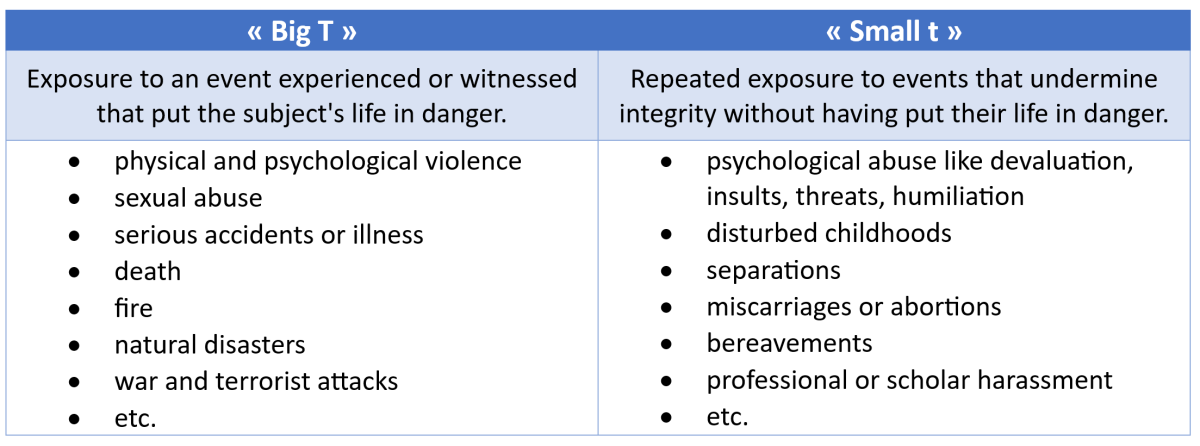Síntomas de estrés postraumático y dolor crónico
" Je ne sais pas ce que le passé nous réserve." Françoise Sagan, Les faux-fuyants, 1991
Hay traumas con T minúscula y traumas con T mayúscula. Lo grande es evidente, violento. Lo pequeño puede pasar desapercibido. No hay que subestimar a ninguno de ellos, y una T pequeña puede esconder una T grande.

Desorden emocionalos trastornos debidos a experiencias traumáticas pueden interferir en el comportamiento humano. Los fisioterapeutas deben ser conscientes de que los síntomas físicos pueden ser un tipo de su expresión en los trastornos de estrés postraumático (TEPT), "un trastorno psiquiátrico que puede presentarse en personas que han experimentado o presenciado un acontecimiento, una serie de acontecimientos o un conjunto de circunstancias traumáticas", según la definición de la Asociación Americana de Psiquiatría.
Existe una alta prevalencia de síntomas de estrés postraumático (SPT) en pacientes que sufren dolor crónico generalizado, de los cuales más de 20% declaran niveles más altos de intensidad del dolor, molestia por el dolor, discapacidad, malestar psicológico, niveles más bajos de autoeficacia, niveles más altos de catastrofización del dolor, percepción de injusticia, fatiga y dificultades para dormir. (Linnemørken et al., 2020). Se han observado correlaciones positivas entre la gravedad del traumatismo y la extensión del dolor, el dolor máximo, la alteración del sueño, el índice de discapacidad por dolor, el estrés, la ansiedad, la depresión y la somatización. (Manuel et al., 2023).
Se recomienda examinar a los pacientes con dolor crónico para detectar el TEPT, ya que se han demostrado asociaciones con la sensibilización central y se ha asumido una relación causal. (McKernan et al., 2019). Los clínicos que tratan con pacientes que sufren dolor crónico deben tener esto en cuenta e investigar tanto la historia real como la pasada, prestando mayor atención al TEPT. Se recomienda el uso de la PCL-5 en contextos no psiquiátricos. (Merians et al., 2023).
Las terapias cognitivo-conductuales son tratamientos de primera línea. Pueden proponerse junto con los farmacológicos. Se pueden encontrar recursos informativos para pacientes, entre otros, en la Asociación Americana de Psiquiatría (www.psychiatry.org).
Linnemørken, L. T. B., Granan, L.-P., & Reme, S. E. (2020). Prevalence of Posttraumatic Stress Symptoms and Associated Characteristics Among Patients With Chronic Pain Conditions in a Norwegian University Hospital Outpatient Pain Clinic. Fronteras de la psicología, 11, 749. https://doi.org/10.3389/fpsyg.2020.00749
Manuel, J., Rudolph, L., Beissner, F., Neubert, T.-A., Dusch, M., & Karst, M. (2023). Traumatic Events, Posttraumatic Stress Disorder, and Central Sensitization in Chronic Pain Patients of a German University Outpatient Pain Clinic. Medicina psicosomática, 85(4), 351-357. https://doi.org/10.1097/PSY.0000000000001181
McKernan, L. C., Johnson, B. N., Crofford, L. J., Lumley, M. A., Bruehl, S., & Cheavens, J. S. (2019). Los síntomas de estrés postraumático median los efectos de la exposición al trauma en los indicadores clínicos de sensibilización central en pacientes con dolor crónico. Revista clínica del dolor, 35(5), 385-393. https://doi.org/10.1097/AJP.0000000000000689
Merians, A. N., Spiller, T., Harpaz-Rotem, I., Krystal, J. H., & Pietrzak, R. H. (2023). Trastorno de estrés postraumático. Clínicas Médicas de Norteamérica, 107(1), 85-99. https://doi.org/10.1016/j.mcna.2022.04.003
Comentarios
 Véronique Bornet
Véronique Bornet I would expect that most PT\'s / manual therapist will remember at least one patient in the last 10 years with expressions of PTSD.
If I look back over my career, I remember several patients who must have had post-traumatic stress, although it went unrecognized at the time. I wish sometimes that I could treat them now, as I learned more about the topic.
I remember a woman talking about an accident in which she fractured her patella. She spoke about it in such emotional detail as if it happened yesterday, but the accident was 5 years ago. I wish I had thought of asking her something as: \"how did this accident impact your life?\"or \"Does this accident haunt you?\" \"Do you dream about your accident?\" She may have more nightmares than before the accident
Another example is a man with a shoulder luxation 3 weeks ago. He was kicked off his bicycle by 3 young guys. He had severe sweating, nervousness, and eyes that could not focus for a longer period of time (got restless). My own accident left me for a while left me with some post-traumatic symptoms suas increased anxiety, palpitations, and irregular heart (all gone now with the help of a well-versed and experienced body worker/cranio sacral therapist). An 81-year golf buddy of ours, an ex-marine from the Vietnam war, recognized only 4 years ago that his inability to stay for longer periods in the same place (he moved a lot over the years after the war; always in education in US army bases of the world), nightmares and bouts of anxiety, were all expressions of a severe post-traumatic stress syndrome. He is getting help in a Veterans hospital in a specialized group. At an IFOMPT Conference in Kopenhagen, Denmark around 1996, a lecture dealt with PTSD. We were warned not to repeat the mechanisms of an accident over and over again in history-taking. (what trauma work would do, is NOT necessarily repeating the mechanisms of the incident -\"what happened\", but guiding and encouraging patients to explore what/how they felt at the time and afterwards.
I recommend readers to explore
- {{ error[0] }}



